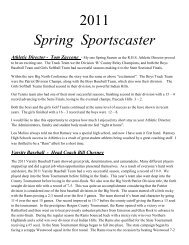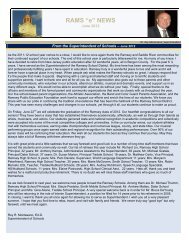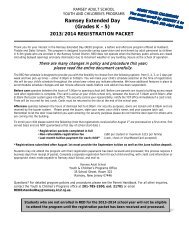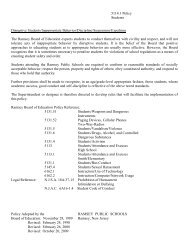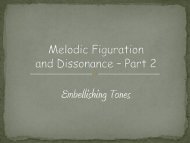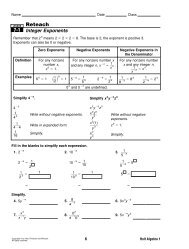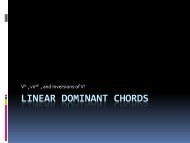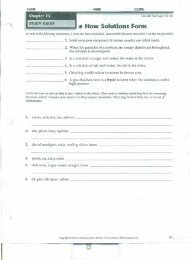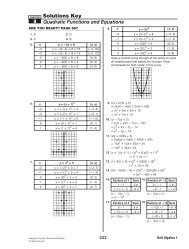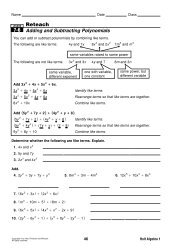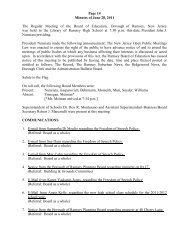Create successful ePaper yourself
Turn your PDF publications into a flip-book with our unique Google optimized e-Paper software.
{<br />
<strong>Musical</strong> <strong>Texture</strong> &<br />
<strong>Chordal</strong> <strong>Spacing</strong>
A network of relationships involving a variety<br />
of musical elements including:<br />
Pitches<br />
Rhythmic patterns<br />
Density<br />
Range<br />
Timbre<br />
Dynamics<br />
Voice doublings<br />
<strong>Texture</strong>
Monophonic <strong>Texture</strong><br />
Single melody line with no accompaniment<br />
Uncommon in the common-practice period<br />
Occur at compositional openings or at a climatic<br />
point<br />
Sibelius: Symphony No.2, I<br />
Types of <strong>Texture</strong>
Homophonic <strong>Texture</strong><br />
<br />
Music with more than one voice part<br />
Attention is drawn to the prominent melodic line the<br />
other voice parts are secondary<br />
<strong>Chordal</strong> or Homorhythmic <strong>Texture</strong><br />
<br />
<br />
All voices proceed in the same rhythm<br />
The ear is drawn to the soprano part; the melody may<br />
appear in other voices<br />
Figured <strong>Chordal</strong> <strong>Texture</strong><br />
<br />
<br />
Series of blocked chords and arpeggiated harmonies<br />
with a consistent figuration<br />
Upper voices of the broken chords act as the principal<br />
melodic line<br />
Types of <strong>Texture</strong>
HOMORHYTHMIC<br />
Bizet: Farandole from L’Arlésienne Suite No. 2<br />
Homophonic <strong>Texture</strong>
FIGURED CHORDAL TEXTURE<br />
Bach: Prelude in C Major from The Well-Tempered Clavier, Book I BWV 846<br />
Homophonic <strong>Texture</strong>
Melody and Accompaniment<br />
<br />
The melodic line is set apart both rhythmically and<br />
spatially from the accompaniment<br />
Bach-Gounod: “Ave Maria”<br />
Types of <strong>Texture</strong>
Contrapuntal / Polyphonic <strong>Texture</strong><br />
<br />
Simultaneous combination of melodic lines<br />
<br />
Each voice maintains its own melodic contour and<br />
rhythmic identity<br />
Free Counterpoint<br />
Imitation<br />
Types of <strong>Texture</strong>
A<br />
Bizet: Farandole<br />
A. Free counter point B. imitation<br />
B<br />
Contrapuntal <strong>Texture</strong>
Strict <strong>Texture</strong><br />
<br />
<br />
<br />
Specific number of voices are retained throughout<br />
an entire composition<br />
Compositionally each voice is maintain separate by<br />
careful stemming of notes and given its own rests<br />
Ex. Two-part inventions; three-part fugue, four-part<br />
chorale style<br />
Free-Voiced <strong>Texture</strong><br />
<br />
Number of voices is not consistent<br />
<br />
Typical of Classical-era instrumental pieces<br />
Strict vs. Free Structure
Distribution of chord member over a specified<br />
number of voices<br />
In both strict and free texture be mindful of the<br />
actual number of parts in a passage; what may<br />
look like four voices may only be three which<br />
are doubled at the octave<br />
Chord Voicing
Simple <strong>Chordal</strong> Style<br />
Note-against-note texture<br />
<br />
<br />
all voice parts maintain the same rhythm<br />
Only tones that are chord members will be used<br />
“Real” music seldom maintains this type of<br />
simplicity for long, usually the texture will be<br />
embellished by figuration (quicker notes in one or<br />
more of the parts)<br />
More on figuration to come later…<br />
Introduction to<br />
Four-Voice <strong>Texture</strong>
Four-voice texture favor by 18 th Century music<br />
theorist for illustrating basic harmonic<br />
progressions<br />
Four-voice literature for choirs and string<br />
quartets help support this preference<br />
When writing for voice, we must consider an<br />
appropriate vocal range for each part; this<br />
range is called tessitura<br />
Introduction to<br />
Four-Voice <strong>Texture</strong>
Soprano Alto Tenor Bass<br />
The four choral voices and the corresponding tessitura. These ranges are<br />
suggested for ease to the composer and singer. Naturally, the range of<br />
each voice part is incumbent upon the individual singer.<br />
Introduction to<br />
Four-Voice <strong>Texture</strong>
Condensed or Closed<br />
Choral Score<br />
Open Choral Score<br />
Keyboard Style<br />
Upper three voices (Sop. Alto. &<br />
Tenor) are in the right hand, and the<br />
bass line is alone in the left hand.<br />
Introduction to<br />
Four-Voice <strong>Texture</strong>
Several standard methods for distributing<br />
voices in a four-voice chord<br />
Chord structures are distinguished by the<br />
intervallic distance between the soprano and<br />
tenor voices<br />
<strong>Chordal</strong> <strong>Spacing</strong> in<br />
Four-Voice <strong>Texture</strong>
Close Structure (C) - less than an octave<br />
between the soprano and tenor voice (Fig. 1)<br />
The chordal 5 th may be omitted in certain root<br />
position seventh chords, a chord member may be<br />
missing between adjacent upper voices (Fig. 2)<br />
Figure 1 Figure 2<br />
5 th omitted<br />
Close Structure
Open Structure (O) – more than an octave<br />
between the soprano and tenor voice<br />
At least one chord member is missing between<br />
the adjacent voices (Fig. 3)<br />
Figure 3<br />
Open Structure
Open Octave/Neutral Structure (O/O) –<br />
commonly found with first inversion chords<br />
Exactly one octave between the soprano and<br />
tenor voice<br />
Octave doubling between soprano & tenor<br />
Open /Octave Structure
The distance between consecutive upper voices<br />
(soprano to alto and alto to tenor) must never<br />
exceed an octave<br />
On the other hand, no restriction is placed on<br />
the distance between the tenor and the bass<br />
(Fig. 4)<br />
Figure 4<br />
avoid<br />
ok!<br />
<strong>Chordal</strong> <strong>Spacing</strong> in<br />
Four-Voice <strong>Texture</strong>
Doublings are inevitable<br />
Doubled voice will occur at the octave or unison<br />
There is a convention from the common-practiceera<br />
of which voices should be doubled<br />
Atypical doublings may occur in certain<br />
harmonic situations<br />
Doubling in<br />
Four-Voice Chords
In root position Major and<br />
minor triads, double the pitch<br />
class that appears in the bass<br />
voice (this will always be the<br />
root of the chord in root<br />
position)<br />
That’s what it means to be in<br />
root position after all!<br />
Voice Doubling<br />
– Root Position
In first inversion Major and<br />
minor chords, double the<br />
pitch class that appears in<br />
the soprano voice<br />
regardless of what chord<br />
member it represents<br />
Voice Doubling<br />
– First Inversion
In second inversion Major and minor triads, double the<br />
pitch class that appears in the bass, the chordal 5 th<br />
Voice Doubling<br />
– Second Inversion
In seventh chords, assign each of the four voices different<br />
pitch classes a separate voice part (Fig. 5)<br />
Occasionally the chordal 5 th may have to be omitted and<br />
the root doubled (Fig. 6)<br />
Figure 5 Figure 6<br />
Voice Doubling<br />
– Seventh Chords
Two-part texture is very common in the music<br />
of the common-practice era.<br />
i.e.; Bach’s Two Part Inventions<br />
Jazz ensemble; trumpet and bass perform<br />
without piano or guitar accompaniment<br />
Dyads only contain two chord members<br />
Triads and seventh chords must be implied in<br />
two-part texture<br />
<strong>Chordal</strong> Implications in<br />
Two-Voice <strong>Texture</strong>
Unison or Octave almost always suggest the root<br />
of a triad<br />
Occurs at the opening or at a phrase cadence<br />
P5 implies a root-position triad<br />
<br />
Missing third is supplied through tonal context<br />
Imperfect consonances; 3 rds and 6 ths<br />
<br />
Imply root-position triads, may imply 1 st inversion<br />
Summary of <strong>Chordal</strong><br />
Implications
Sixths usually suggest triadic first inversions via 3 rd<br />
and root<br />
If comprised of ^5 and ^3 it may imply a 6/4 or<br />
second inversion sonority<br />
<br />
Seventh chords involve two inversions of the majorminor<br />
7 th (dominant 7 th )<br />
Diminished 5 th (chordal 3 rd and 7 th ) suggest a 6/5 or<br />
first inversion<br />
<br />
Augmented 4 th (chordal 7 th and 3 rd ) suggest a 4/2 or<br />
third inversion<br />
Summary of <strong>Chordal</strong><br />
Implications
Two-Part <strong>Chordal</strong> Practice



